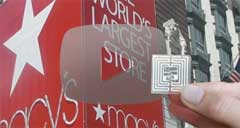Target Looks In New Places to Reduce Out-of-Stocks
Target stores is taking a new approach to the never ending challenge of out of stocks - and the focus is on what I have often referred to as in-store logistics.
Supply Chain Digest Says... |
 |
| With the RFID program's success and resulting confidence in its store inventories, Macy's will now allocate inventory for on-line orders even if the system shows that just one unit is available in a given store. |
 |
|
|
Hoping to reduce labor costs and out-of-stocks, Target managers are pouring over many categories of products it sells to see how many different formats and pack sizes of products like bottled water or soap it really needs to stock in its stores - and reduce complexity in store logistics as the same time.
For example, Target found that for one type of peanut butter, its shelf could only hold 18 units. But the case pack from the manufacturer was 24, meaning Target always has to take a partial case from the backroom to the floor.
Of course it's not just that simple - maybe other retailers prefer case packs of 24 instead of 18.
Visit the Retail Vendor Performance Management home page to learn more
and subscribe to the monthly newsletter.
Target is taking includes putting more product on the sales floor rather than the stockroom by redesigning shelves, and reducing total SKU counts in many categories.
As it considers cutting back those SKUs, Target is going to test the new merchandising plans at one store to gauge customer response.
Of course, when Walmart took thousands of products off its shelves in 2009 during the recession it later blamed that move on slumping US store sales, bringing some 8500 items back into its stores in 2011, using "It's Back" flags on the items being returned to the shelves.
Macy's "Picking to the Last Unit" in Store
 It's a concept that Macy's has been promoting for a while, but recently there were additional news reports relative to the department store chain's Pick to the Last Unit (P2LU) strategy for Omnichannel order fulfillment. It's a concept that Macy's has been promoting for a while, but recently there were additional news reports relative to the department store chain's Pick to the Last Unit (P2LU) strategy for Omnichannel order fulfillment.
The basic idea is simple: as retailers move to store-based fulfillment for on-line and mobile orders - a strategy Macy's has aggressively pursued in recent years - they have been reluctant to peg a given store to fill an order if the quantity shown in the perpetual inventory system is low. Why? Because store perpetual inventories are notoriously inaccurate, risking that the item could not be found for shipment after the order was accepted.
Macy's has been an aggressive adopter of item-level RFID, driven it seems primarily by its interest in using store-level fulfillment.
In 2013, for example, a senior Macy's executive noted that ""We're extremely excited about the accuracy that this is going to bring to our business, because having the exact volume - exact quantity of product in the stores when we think we have it - will be a huge sales driver," especially for ecommerce.
Macy's has been rolling out its RFID program product by product, department by department, over the past few years.
With the RFID program's success and resulting confidence in its store inventories, Macy's will now allocate inventory for on-line orders even if the system shows that just one unit is available in a given store - thus the name "Pick to the Last Unit."
As a result, Macy's says sales should increase, as they lone item can be sold on-line perhaps easier than waiting for a customer in-store. Macy's said that it has demonstrated this over the past year in a test with women's dresses, for which it found it could accurately fulfill on-line fashion orders from the last units for sale.
Another benefit is that these low inventory items will more likely to be sold at or near full price, versus the markdowns that are often necessary to move such low quantity items, a result also confirmed during the test with dresses. Finally, the system will inform store associates where the item is based on the last RFID cycle count taken, and allow them to find the item if it has moved since then by using handheld readers, both of which should reduce associate search times.
Perhaps surpassingly, "About 15% to 20% of inventory is accounted for by the last unit in the store," said Peter Longo, president of logistics and operations at Macy's. "It's a massive amount of budget, either marked down or not sold, and it is curable through RFID."
Of course, adopting item-level RFID puts a whole new set of rules and performance monitoring requires upon retailers. Vendor Compliance is of course key to success.
Williamsburg Garment Company Having Made in USA Success with High End Jeans
When Williamsburg Garment Company (WCG) launched its first Made in the USA style in 2013 - the Hope Street Jean - the response was so positive that the company moved all of its operations from China back to the United States.
WGC president Maurice Malone says the company's mission "is to rival America's largest and oldest denim brands which now produce overseas, by producing and marketing competitively priced, top quality, Made in the USA products."
Malone adds that "we have no intentions to be like the other big American brands producing mostly overseas in low labor cost countries and selling inferior products at mass volume discount retailers which specialize in selling imported and cheap products."
Ninety percent of the fabrics WCG uses are American made by Cone Mills, with the balance from top Japanese denim producers. Despite being made in the US with mostly US fabrics, WCG jeans sell for about 20% less than competitive high end jeans.
Your Comments/Feedback
|